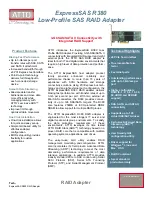
Scenario 1:6 – VLAN Tagging (802.1Q) with Multiple Shared Uplink Sets (SUS) and Link Aggregation using LACP (802.3ad) –
VMware ESX 84
Figure 1-75
Configuring NIC Port 2 with Multiple Networks, PROD-A-2 is not tagged, Note; that both NICs are
configured with the same settings below, except NIC 2 is connected to PROD-x-2.
Note: the above graphic is an example of a how an ESX hypervisor might be configured for multiple
VLANs. In this case both NICs are configured for networks VLAN-Trunk-1 and VLAN-Trunk-2, supporting
PROD-A-1&2 though PROD-D-1&2 which are mapped to VLANs 101-104. Any frames received by
Virtual Connect for this server will have their tags intact and forward to the server NICs, therefore acting
as a TRUNK port. This works well for a hypervisor host/vSwitch that can be configured to interpret the
tag. In addition, PROD-A is defined as the default VLAN, therefore any frames received by VC for VLAN
101 will be forwarded to the server NIC, with the tags removed. This would work well for the console
NICs, so that the console does not need to be configured to understand the VLAN tags. It we did not un-
tag VLAN 101, then the ESX console would need to be configured for this VLAN.
Summary
We created a Virtual Connect Shared Uplink Set (SUS) to support 4 VLANs (101-104). The SUS was
created with Active and standby uplinks, to provide both additional bandwidth and availability.
When VC profile ESX-1 is applied to the server in bay1 and is powered up, it has two NICs configured
for “Multiple Networks” which connects to the network infrastructure through two (active) 1Gb uplinks.
These NICs are configured to support LANs 101 through 104 with VLAN 101 configured as Default
(untagged), so the operating system does not need to understand which VLAN it is on.
As this is an ESX environment, both NICs would be connected to a vSwitch with port groups configured
for VLANs 102 through 104. VLAN 101 would be configured as the console network.
As additional servers are added to the enclosure, simply create additional profiles, configure the NICs for
Multiple Networks and apply them to the appropriate server bays.
















































